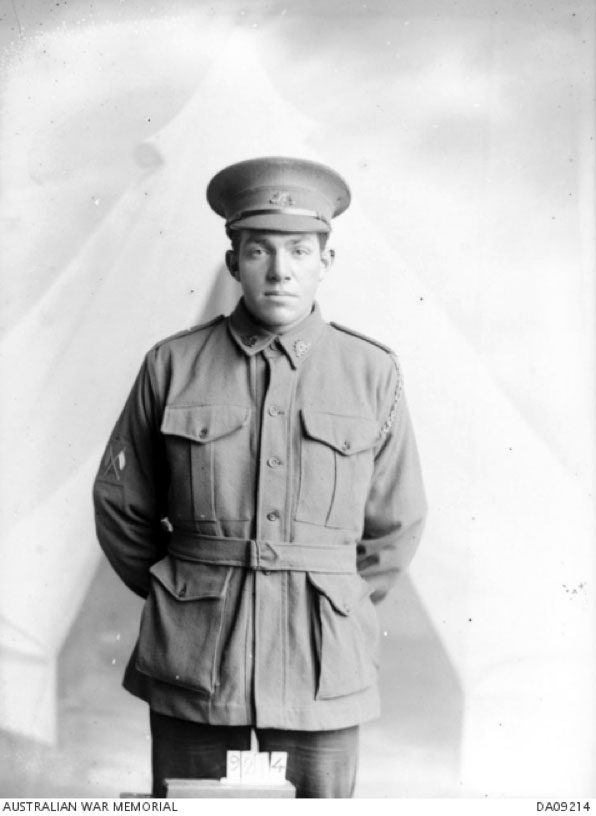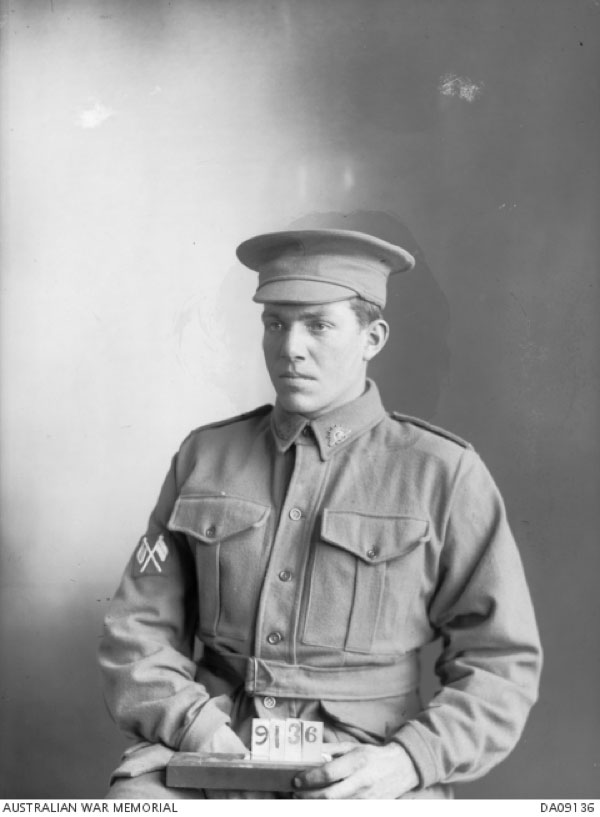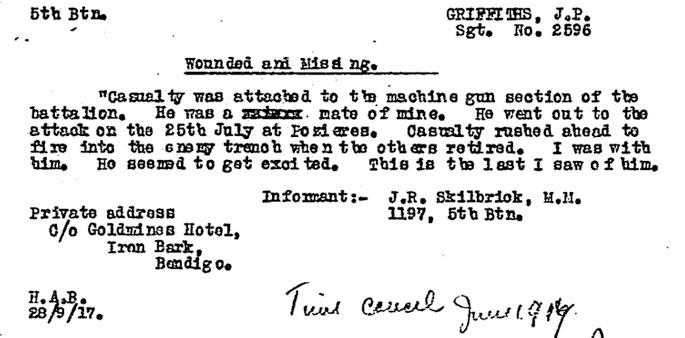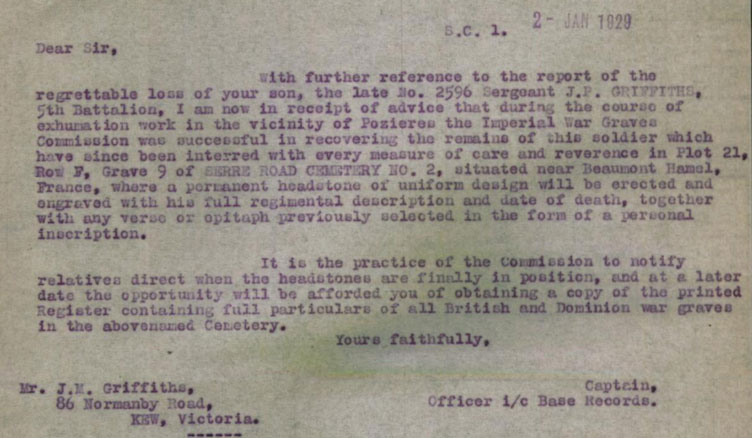John Pargeter GRIFFITHS

John Griffiths was born on 17 April 1893 in Kew, Victoria. His parents were John Moore and Margaret Wightman (née Davidson) Griffiths. He attended Scotch from 1905 to 1910.
John was an engineer (Scotch records say motor mechanic) when he enlisted on 7 April 1915 at Melbourne. He served in the 5th Battalion with the rank of Sergeant. His Regimental Number was 2596.
John died on 25 July 1916 at Pozieres. He was 23 years of age.
Service record
On enlistment John ‘Jack’ Griffiths was allotted to the 8th reinforcements of the 5th Battalion as an Acting Corporal. On 7 December he reached the battalion on Gallipoli and, as was typical, was reverted to Private. He stayed there until the evacuation in December. In January 1916 he was promoted to Lance Corporal in Egypt, where after a course in February-March he qualified as a machine-gun instructor. He was transferred to the Battalion Machine-Gun Section.
He arrived with the battalion in France on 30 March. On 6 June he was promoted to Sergeant. On 25 July he was posted wounded and missing at Pozieres. A friend from the same battalion wrote soon after the battle: ‘I did not see Jack on the morning of the fight, but several others saw him busily using his gun. Later he apparently aided in the bombing that had been in progress for some time. Let me say in closing how greatly his gunners esteemed him.’
A Court of Enquiry held on 26 November 1917 declared that he had been killed in action on 25 July. A fellow member of the Light Machine Gun Section, Private Stanley Crichton, said in a declaration in August 1917: ‘We were in the line at Pozieres and the Germans were holding part of the same trench as we were. There was a heavy bayonet duel and Sgt Griffiths rushed the Germans. He must have been taken prisoner or killed.’ On another occasion, though, Crichton reportedly said that he had seen Griffiths killed by a ‘bomb’ (grenade). Another soldier in his section claimed that when the unit had to retire, Jack ‘sort of went silly’ and went the wrong way, breaking out of the man’s grip as he tried to hold him back. This soldier later gave testimony that Jack had run towards the German trench to fire into it.
Jack’s service record contains a letter that his father wrote in October 1917 saying that the last he had heard of his son was in July 1917, when he was told that his son was missing. ‘Have you any further news?’, he asked. There is another letter from 1919 explaining that it took 15 months for Jack’s ‘missing’ status to be changed to ‘killed’ and that he had since heard nothing more. He wanted more information (see below). The official reply offered no more information, but then, 10 years later the father was sent a letter in which he was informed that John’s body had been found at Pozieres and reinterred at the Serre Road Cemetery (see below). A similar story affected Frank Lynall and Edwin Muntz. The father sent a ‘hearty thanks’ to the officer who wrote the letter. Two identity discs found on Jack’s body were also sent to his father.
A few months before his death Jack wrote: ‘This life makes one think deeply, and the more thinking I do the more I see the hopelessness and futility of a life spent apart from Christ. In His strength I want to live the straight, clean life.’ In a letter quoted in Jack’s The Scotch Collegian obituary one of Jack’s friends from the same battalion said that Jack had in fact been ‘admired and looked up to as a straight man.’
John Griffiths is buried in the Serre Road Cemetery No. 2, France.
Photographs and Documents:

Photo of Private Jack Pargeter at Broadmeadows in about May 1915

A 1915 photograph of Private John Griffiths, who is wearing the patch of a qualified signaller.

Testimony about Jack Griffiths’ fate from a mate, in Griffiths’ Red Cross Wounded and Missing file

Letter from John Griffiths’ father in his service record, concerning his son’s fate

Letter from John Griffiths’ service record concerning the recovery and reburial of his body.
Sources:
- Australian War Memorial – Roll of Honour and Red Cross Wounded and Missing file
- Mishura Scotch Database
- National Archives of Australia – B2455, GRIFFITHS JP
- Scotch Collegian 1918
- The AIF Project - https://www.aif.adfa.edu.au/showPerson?pid=120135